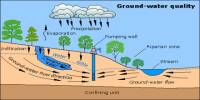Main objective of this lecture is to present on Longshore Drift. It is the movement of sediments most often sand, along a coast parallel to its shoreline – a zig-zag movement of sediment along the beach. The largest beach sediment is found where the process begins, updrift, and the smallest, most easily moved, downdrift. Where waves are strong, the coast will be eroded and sediment carried away and where they are weak sediment will be deposited. Longshore drift can have undesirable effects for humans, such as beach erosion. To prevent this, sea defences such as groynes or gabions may be employed.
Presentation on Longshore Drift
















